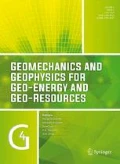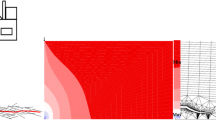Abstract
This paper simulates the propagation of hydraulic fractures under constant fluid pressure using the isogeometric analysis based on boundary element methods (BEM) i.e. the so called isogeomtric BEM. Due to the seamless integration between computer aided design (CAD) and numerical analysis, the isogeomtric BEM eliminates the meshing procedure and geometric errors, and explicitly parametrizes the crack propagation path. Graded knot insertion near the crack tip is used to effectively capture the stress singularity at the crack tip. The M integral is adopted to extract the stress intensity factors (SIFs). The crack surface and propagation path can be parameterized explicitly with Non-Uniform Rational B-splines (NURBS). The comparison of our numerical results with laboratory experiments and other numerical methods validates the effectiveness of the algorithm. Moreover, we investigate the influence of different factors, including the confining pressure, crack numbers, pore pressure, and natural cracks, on hydraulic fractures and study how multiple cracks propagate under various conditions.
Article highlights
-
The isogeomtric BEM is used to simulate hydraulic fracturing process that is able to eliminate the meshing procedure and geometric errors.
-
The crack surface and propagation path can be parameterized explicitly with Non-Uniform Rational B-splines (NURBS).
-
We investigate the influence of different factors on pressurized fractures and study how multiple cracks propagate under various conditions.





















Similar content being viewed by others
References
Areias P, Msekh M, Rabczuk T (2016) Damage and fracture algorithm using the screened poisson equation and local remeshing. Eng Fract Mech 158:116–143. https://doi.org/10.1016/j.engfracmech.2015.10.042
Becker A (1992) The boundary element methods in engineering. McGraw-Hill Book Company, New York
Belytschko T, Black T (1999) Elastic crack growth in finite elements with minimal remeshing. Int J Numer Meth Eng 45(5):601–620
Bruno M, Nakagawa F (1991) Pore pressure influence on tensile fracture propagation in sedimentary rock. Int J Rock Mech Mining Sci Geomech Abst 28(4):261–273. https://doi.org/10.1016/0148-9062(91)90593-B
Carrier B, Granet S (2012) Numerical modeling of hydraulic fracture problem in permeable medium using cohesive zone model. Eng Fract Mech 79:312–328
Chen L, Liu C, Zhao W, Liu L (2018) An isogeometric approach of two dimensional acoustic design sensitivity analysis and topology optimization analysis for absorbing material distribution. Comput Methods Appl Mech Eng 336:507–532
Chen L, Marburg S, Zhao W, Liu C, Chen H (2019a) Implementation of isogeometric fast multipole boundary element methods for 2d half-space acoustic scattering problems with absorbing boundary condition. J Theoret Comput Acoust 27(02):1850024
Chen L, Lian H, Liu Z, Chen H, Atroshchenko E, Bordas S (2019b) Structural shape optimization of three dimensional acoustic problems with isogeometric boundary element methods. Comput Methods Appl Mech Eng 355:926–951
Chen L, Zhang Y, Lian H, Atroshchenko E, Ding C, Bordas S (2020a) Seamless integration of computer-aided geometric modeling and acoustic simulation: Isogeometric boundary element methods based on catmull-clark subdivision surfaces. Adv Eng Softw 149:102879
Chen L, Lu C, Lian H, Liu Z, Zhao W, Li S, Chen H, Bordas S (2020b) Acoustic topology optimization of sound absorbing materials directly from subdivision surfaces with isogeometric boundary element methods. Comput Methods Appl Mech Eng 362:112806
Chen L, Lu C, Zhao W, Chen H, Zheng CJ (2020c) Subdivision surfaces–boundary element accelerated by fast multipole for the structural acoustic problem. J Theoret Comput Acoust 28(2):2050011–1–27
Cox M (1972) The numerical evaluation of B-splines. IMA J Appl Math 10(2):134–1492
Cruse T (1996) Bie fracture mechanics analysis: 25 years of developments. Comput Mech 18(1):1–11
Cruse T, Rizzo F (1968) A direct formulation and numerical solution of the general transient elastodynamic problem i. J Math Anal Appl 22(1):244–259
De Boor C (1972) On calculating with B-splines. J Approx Theory 6(1):50–62
Duan K, Li Y, Yang W (2021) Discrete element method simulation of the growth and efficiency of multiple hydraulic fractures simultaneously-induced from two horizontal wells. Geomech Geophys Geo-Energy Geo-Resour. https://doi.org/10.1007/s40948-020-00196-4
Erdogan F, Sih G (1963) On the crack extension in plates under plane loading and transverse shear. J Basic Eng 85(4):519
Gordeliy E, Peirce A (2015) Enrichment strategies and convergence properties of the XFEM for hydraulic fracture problems. Comput Methods Appl Mech Eng 283:474–502
Guiggiani M, Krishnasamy G, Rudolphi T, Rizzo F (1992) A general algorithm for the numerical solution of hypersingular boundary integral equations. J Appl Mech 59(3):604–614
He B, Zhuang X (2018) Modeling hydraulic cracks and inclusion interaction using XFEM. Underground space 3(3):218–228
Hong H, Chen J (1988) Derivations of integral equations of elasticity. J Eng Mech 114(6):1028–1044
Hu Y, Li X, Zhang Z, He J, Li G (2020) Numerical investigation on the hydraulic stimulation of naturally fractured longmaxi shale reservoirs using an extended discontinuous deformation analysis (DDA) method. Geomech Geophys Geo-Energy Geo-Resour 6(4):1–21
Hughes T, Cottrell J, Bazilevs Y (2005) Isogeometric analysis: Cad, finite elements, NURBS, exact geometry and mesh refinement. Comput Methods Appl Mech Eng 194(39–41):4135–4195
Khoei A, Hirmand M, Vahab M, Bazargan M (2015) An enriched FEM technique for modeling hydraulically driven cohesive fracture propagation in impermeable media with frictional natural faults: Numerical and experimental investigations. Int J Numer Meth Eng 104(6):439–468
LaGreca R, Daniel M, Bac A (2005) Local deformation of NURBS curves. Math Methods Curves Surf Tromso 2004:243–252
Lecampion B (2009) An extended finite element method for hydraulic fracture problems. Commun Numer Methods Eng 25(2):121–133
Li K, Qian X (2011) Isogeometric analysis and shape optimization via boundary integral. Comput Aided Des 43(11):1427–1437
Li C, Niu Z, Hu Z, Hu B, Cheng C (2019) Effectiveness of the stress solutions in notch/crack tip regions by using extended boundary element method. Eng Anal Boundary Elem 108:1–13
Li Z, Li X, Yu J, Cao W, Wang X (2020) Influence of existing natural fractures and beddings on the formation of fracture network during hydraulic fracturing based on the extended finite element method. Geomech Geophys Geo-Energy Geo-Resour 6(4):58
Lian H, Kerfriden P, Bordas S (2016) Implementation of regularized isogeometric boundary element methods for gradient-based shape optimization in two-dimensional linear elasticity. Int J Numer Meth Eng 106(12):972–1017
Lian H, Kerfriden P, Bordas S (2017) Shape optimization directly from CAD: An isogeometric boundary element approach using t-splines. Comput Methods Appl Mech Eng 317:1–41
Liu Y, Rudolphi T (1991) Some identities for fundamental solutions and their applications to non-singular boundary element formulations. Eng Anal Boundary Elem 8(6):301–311
Liu C, Chen L, Zhao W, Chen H (2017) Shape optimization of sound barrier using an isogeometric fast multipole boundary element method in two dimensions. Eng Anal Boundary Elem 85:142–157
Lo L (2014) Interaction of growing cracks in hydraulic fracturing. Ph.D. thesis
Miehe C, Hofacker M, Welschinger F (2010a) A phase field model for rate-independent crack propagation: Robust algorithmic implementation based on operator splits. Comput Methods Appl Mech Eng 199(45–48):2765–2778
Miehe C, Welschinger F, Hofacker M (2010b) Thermodynamically consistent phase-field models of fracture: Variational principles and multi-field FE implementations. Int J Numer Meth Eng 83(10):1273–1311
Moës N, Dolbow J, Belytschko T (1999) A finite element method for crack growth without remeshing. Int J Numer Meth Eng
Mohammadnejad T, Khoei A (2013) An extended finite element method for hydraulic fracture propagation in deformable porous media with the cohesive crack model. Finite Elem Anal Des 73:77–95
Nguyen B, Tran H, Anitescu C, Zhuang X, Rabczuk T (2016) An isogeometric symmetric galerkin boundary element method for two-dimensional crack problems. Comput Methods Appl Mech Eng 306:252–275
Nguyen V, Lian H, Rabczuk T, Bordas S (2017) Modelling hydraulic fractures in porous media using flow cohesive interface elements. Eng Geol 225:68–82
Niu Z, Cheng C, Zhou H, Hu Z (2007) Analytic formulations for calculating nearly singular integrals in two-dimensional BEM. Eng Anal Boundary Elem 31(12):949–964
Niu Z, Cheng C, Ye J, Recho N (2009) A new boundary element approach of modeling singular stress fields of plane V-notch problems. Int J Solids Struct 46(16):2999–3008
Niu Z, Hu Z, Cheng C, Zhou H (2015) A novel semi-analytical algorithm of nearly singular integrals on higher order elements in two dimensional BEM. Eng Anal Bound Elem 61:42–51
Ortiz M, Pandolfi A (1999) Finite-deformation irreversible cohesive elements for three-dimensional crack-propagation analysis. Int J Numer Meth Eng 44(9):1267–1282
Paluszny A, Zimmerman R (2013) Numerical fracture growth modeling using smooth surface geometric deformation. Eng Fract Mech 108:19–36
Peng X, Atroshchenko E, Kerfriden P, Bordas S (2017a) Isogeometric boundary element methods for three dimensional static fracture and fatigue crack growth. Comput Methods Appl Mech Eng 316:151–185
Peng X, Atroshchenko E, Kerfriden P, Bordas S (2017b) Linear elastic fracture simulation directly from CAD: 2d NURBS-based implementation and role of tip enrichment. Int J Fract 204(1):55–78
Rogers D (2000) An introduction to NURBS: with historical perspective. Elsevier, New York
Rudolphi T (1991) The use of simple solutions in the regularization of hypersingular boundary integral equations. Math Comput Model 15(3–5):269–278
Scott M, Simpson R, Evans J, Lipton S, Bordas S, Hughes T, Sederberg T (2013) Isogeometric boundary element analysis using unstructured t-splines. Comput Methods Appl Mech Eng 254:197–221
Seybert A, Soenarko B, Rizzo F, Shippy D (1985) An advanced computational method for radiation and scattering of acoustic waves in three dimensions. J Acoust Soc Am 77(2):362–368
Simpson R, Trevelyan J (2011) A partition of unity enriched dual boundary element method for accurate computations in fracture mechanic. Comput Methods Appl Mech Eng 200(1–4):1–10
Simpson R, Bordas S, Trevelyan J, Rabczuk T (2012) A two-dimensional isogeometric boundary element method for elastostatic analysis. Comput Methods Appl Mech Eng 209:87–100
Simpson R, Bordas S, Lian H, Trevelyan J (2013) An isogeometric boundary element method for elastostatic analysis: 2d implementation aspects. Comput Struct 118:2–12
Simpson R, Scott M, Taus M, Thomas D, Lian H (2014) Acoustic isogeometric boundary element analysis. Comput Methods Appl Mech Eng 269:265–290
Sneddon I (1995) Fourier transforms. McGraw-Hill, New York
Telles J (1987) A self-adaptive co-ordinate transformation for efficient numerical evaluation of general boundary element integrals. Int J Numer Methods Eng 24(5):959–973
Yau J, Wang W, Corten H (1980) A mixed-mode crack analysis of isotropic solids using conservation laws of elasticity. J Appl Mech 47(2):335–341
Zhang B, Ji B, Liu W (2017) The study on mechanics of hydraulic fracture propagation direction in shale and numerical simulation. Geomechanics and Geophysics for Geo-Energy and Geo-Resources 4:119–124
Zienkiewicz O, Taylor R (1977) The finite element method. McGraw-Hill Book Company, New York
Acknowledgements
The authors appreciate the financial supports from the National Natural Science Foundation of China (NSFC) (Nos. 51904202, 11702238, 52004203, 51904196). Peng would like to acknowledge the Natural Science Foundation of the Jiangsu Higher Education Institutions of China [Grant No. 18KJB130006].
Author information
Authors and Affiliations
Corresponding author
Ethics declarations
Conflict of interest
The authors declare that they have no conflict of interest.
Additional information
Publisher's Note
Springer Nature remains neutral with regard to jurisdictional claims in published maps and institutional affiliations.
Rights and permissions
About this article
Cite this article
Chen, L., Wang, Z., Peng, X. et al. Modeling pressurized fracture propagation with the isogeometric BEM. Geomech. Geophys. Geo-energ. Geo-resour. 7, 51 (2021). https://doi.org/10.1007/s40948-021-00248-3
Received:
Accepted:
Published:
DOI: https://doi.org/10.1007/s40948-021-00248-3




